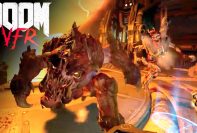Last week I played through the first two levels of the game Psychonauts in VR , developed and published by Double Fine Productions. This is a point and click adventure game played in first-person view using the Oculus Rift VR headset. The game is a sequel to a PlayStation 2 game of the name, Psychonauts , developed by Double Fine.
Sony’s PlayStation VR may have been a bit of a disappointment in terms of availability, but that doesn’t mean the system is without its merits. While I’ve only had a couple of hands-on sessions with the system, I’ve been a huge fan of VR since I first tried the Oculus Rift.
The latest game from Double Fine Productions, Psychonauts In The Rhombus of Ruin, is a psychedelic trip into the minds of characters from the surreal and wacky world of psychic spy Scott Mccarthy, the sinister corporation Colorman, and a group of kids drawn into a world of espionage and deception.
Between the events of Psychonauts (2005) and the forthcoming Psychonauts 2 due out later this year, Psychonauts In the Rhombus of Ruin takes place. In the Rhombus of Ruin, which is only accessible in VR, departs from its flatscreen siblings’ 3D platformer genre and harkens back to the early days of point-and-click games with a mobility system that allows you to transfer your consciousness into other living beings.
Gameplay
The narrative continues where Psychonauts ended, with Raz, Lili, Sasha, Milla, and Coach Oleander flying out to save Truman Zannotto, the Grand Head of the Psychonauts. You’re transported into the heart of the Rhombus of Ruin, an extremely mysterious and deadly region of the ocean comparable to the Bermuda Triangle, for Raz’s first assignment as a true member of the super hero squad. With the rescue party’s aircraft trapped in the Rhombus of Ruin, you’re left with nothing but your psychic skills to rejoin the rest of the Psychonauts, discover the identity of the mystery kidnapper, and release Truman before the Rhombus’ lunacy drives everyone insane. In a nutshell, it’s the storyline of an animated adventure that might be seen in cinemas or on Cartoon Network.
Despite being abducted and having your squad cast a mind-bending spell by an unknown foe, the game only has one (quite mild) combat scenario and instead focuses on puzzles. With the power to transfer your mind to any living creature in sight, you’ll use buttons and levers to explore levels and solve puzzles, as well as some of your other psychic abilities like pyrokinesis and a psy-blast, a percussive rush of mental energy.

The puzzles vary in complexity from very basic (find the code) to a bit more challenging (but still quite easy). Raz, the protagonist, is voiced, much to my dismay, so you’ll always have that helpful hand to guide you through each problem. On principle, I find this irritating because if you don’t get something right right away, you’ll be forced to listen to an exclamatory (and completely unprompted) piece of repeated dialogue to the effect of “I wonder what would happen if I try this obvious answer.” The voice acting, on the other hand, is excellent, taking the edge off what might otherwise be a frustrating nuisance. Finally, I found the problems to be diverse yet too easy to hold my interest.
The Psychonauts series is known for its campy humor, but it’s the kind of corny dad jokes that make you moan but also grin a little.

While the level design only allows for a straight route through the game, it does take you through a diverse set of locations. The entire forward push through became a bit too paint-by-numbers for me after a while, as you teleport from nodes that always arrive on cue, whether it’s a fish that swims into view or a rat that scurries out of a hiding spot just in time. Because you’re continually carried along by Raz’s friendly guidance, there’s little to no real exploring to be done, which is a pity given how tempting everything seems.
In the end, I thought the 1.5-hour playtime duration was a bit short, especially considering the sudden conclusion, which left me feeling a little disappointed.
Immersion
One of the first things you notice about the Psychonauts in Rhombus of Ruin is how beautiful they are. The graphic style really captures an amazing atmosphere, making you feel as if you’ve walked into a late-90s Saturday morning cartoon.
 picture courtesy of
picture courtesy of
The character design is nothing short of brilliant, not just in terms of color and texture, but also in terms of how the characters express themselves. To that end, I thought the world’s humanoid beings approached the uncanny valley a bit too close—if only because of how lifelike they behaved while yet looking really strange from the 1:1 immersive perspective of a VR headset. The most of the time, you’re flying from one cartoony animal to the next, or to the odd diving suit-wearing adversary, so it’s not anything I got too worked up about.
 picture courtesy of
picture courtesy of
Because you are a bodiless, handleless creature that pops into the brains of other individuals and species, you have no hands. But you don’t have arms even when you should, making the experience a bit less immersive than it might have been. Because you don’t have any hands, you use telekinesis to interact with the world’s numerous items, which works out quite nicely.
My main issue with Rhombus of Ruin in terms of immersion is the continuous talk from both Raz and your teammates, but you’ve already heard me complain about that. Everything about Psychonauts leads me to think it’s aimed for a younger adolescent audience, and let’s face it: those kids don’t know when to stop talking, so it’s a lot less damning than I make it out to be on the surface.
Comfort
While gaze-based controls suit the overall psychic ability theme, they may be clunky at times. It’s not always simple to highlight and pick an item or node, and I found myself having to use my neck for something it wasn’t intended for—as a fine point device, which I know may cause neck pain over time. I didn’t have any problems with my neck stiffening up because of the game’s short duration, but I wouldn’t want to go in for a 2-hour session if the game were longer.
Aside from that, node teleportation is by far one of the most pleasant methods to move about a VR game, albeit it comes with the typical drawbacks of restricting visual continuity and lowering the player’s overall immersion by a few milliseconds.
Related Tags
This article broadly covered the following related topics:
- saturday morning pancakes podcast
- saturday morning pancakes christmas
- saturday morning cartoon podcast
- saturday many rewind
- saturday morning rewind youtube



